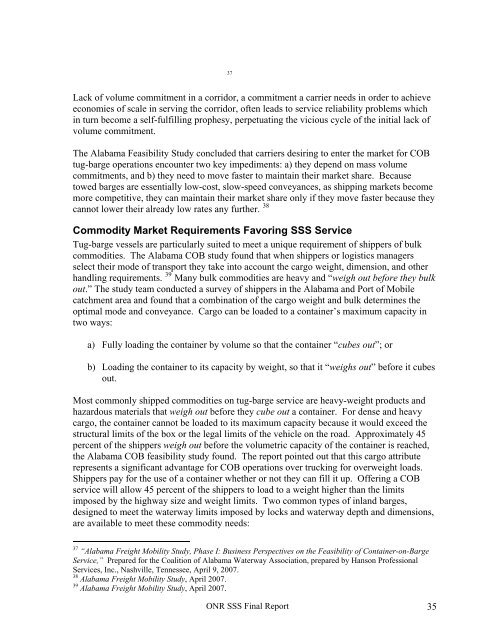Office of Naval Research - National Transportation Library
Office of Naval Research - National Transportation Library
Office of Naval Research - National Transportation Library
Create successful ePaper yourself
Turn your PDF publications into a flip-book with our unique Google optimized e-Paper software.
37Lack <strong>of</strong> volume commitment in a corridor, a commitment a carrier needs in order to achieveeconomies <strong>of</strong> scale in serving the corridor, <strong>of</strong>ten leads to service reliability problems whichin turn become a self-fulfilling prophesy, perpetuating the vicious cycle <strong>of</strong> the initial lack <strong>of</strong>volume commitment.The Alabama Feasibility Study concluded that carriers desiring to enter the market for COBtug-barge operations encounter two key impediments: a) they depend on mass volumecommitments, and b) they need to move faster to maintain their market share. Becausetowed barges are essentially low-cost, slow-speed conveyances, as shipping markets becomemore competitive, they can maintain their market share only if they move faster because theycannot lower their already low rates any further. 38Commodity Market Requirements Favoring SSS ServiceTug-barge vessels are particularly suited to meet a unique requirement <strong>of</strong> shippers <strong>of</strong> bulkcommodities. The Alabama COB study found that when shippers or logistics managersselect their mode <strong>of</strong> transport they take into account the cargo weight, dimension, and otherhandling requirements. 39 Many bulk commodities are heavy and “weigh out before they bulkout.” The study team conducted a survey <strong>of</strong> shippers in the Alabama and Port <strong>of</strong> Mobilecatchment area and found that a combination <strong>of</strong> the cargo weight and bulk determines theoptimal mode and conveyance. Cargo can be loaded to a container’s maximum capacity intwo ways:a) Fully loading the container by volume so that the container “cubes out”; orb) Loading the container to its capacity by weight, so that it “weighs out” before it cubesout.Most commonly shipped commodities on tug-barge service are heavy-weight products andhazardous materials that weigh out before they cube out a container. For dense and heavycargo, the container cannot be loaded to its maximum capacity because it would exceed thestructural limits <strong>of</strong> the box or the legal limits <strong>of</strong> the vehicle on the road. Approximately 45percent <strong>of</strong> the shippers weigh out before the volumetric capacity <strong>of</strong> the container is reached,the Alabama COB feasibility study found. The report pointed out that this cargo attributerepresents a significant advantage for COB operations over trucking for overweight loads.Shippers pay for the use <strong>of</strong> a container whether or not they can fill it up. Offering a COBservice will allow 45 percent <strong>of</strong> the shippers to load to a weight higher than the limitsimposed by the highway size and weight limits. Two common types <strong>of</strong> inland barges,designed to meet the waterway limits imposed by locks and waterway depth and dimensions,are available to meet these commodity needs:37 “Alabama Freight Mobility Study, Phase I: Business Perspectives on the Feasibility <strong>of</strong> Container-on-BargeService,” Prepared for the Coalition <strong>of</strong> Alabama Waterway Association, prepared by Hanson Pr<strong>of</strong>essionalServices, Inc., Nashville, Tennessee, April 9, 2007.38 Alabama Freight Mobility Study, April 2007.39 Alabama Freight Mobility Study, April 2007.ONR SSS Final Report 35
















